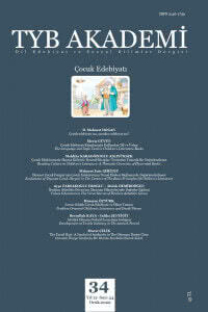İstihdam Politikalarında Yeni Arayışlar: Osmanlı Dönemi Mostar Vakıfları Üzerinden Üçüncü Sektör Sorgulaması
Meslek kollarının sınırlı, tarım üretiminin yaygın, her türden üretimin insan gücüne dayandığı ve devletin istihdam oluşturmadaki rolünün sınırlı olduğu bir ekonomide istihdamı düzenleyen günümüzdekinden farklı alternatif kurumları ortaya çıkarmak ve bu kurumların istihdam üzerindeki etkilerini belirginleştirmek bu çalışmanın temel motivasyon kaynağıdır. Bir diğer ifadeyle istihdamda üçüncü sektör merkezli yeni paradigma arayışına çıkılmaktadır. Araştırmada ilk olarak toplumun üçüncü sektör algısı eleştirel olarak değerlendirilmekte ve bu algının sınırlayıcı sonuçları soruşturulmaktadır. Diğer yandan üçüncü sektörün birlikte yaşama dair inşacı ve kurucu gücü Osmanlı Dönemi Mostar vakıfları üzerinden agümante edilmekte ve istihdam yaratma potansiyeline işaret edilmektedir. Tüm bu süreçte Osmanlı toplumunun üçüncü sektör ufku da görücüye çıkarılmaktadır. İster kamusal ister özel olsun geniş spektrumda mal ve hizmet üreten sivil toplum kuruluşları, her halükarda bireysel kar/fayda maksimizasyonu yerine toplumsal fayda için üretim yapmaktadır. Toplum için dahi olsa üretim operasyonlarında sürdürülebilir ve nitelikli insan kaynağına ihtiyaç duyan üçüncü sektörün sahip olduğu ahlâkî ve iktisadî potansiyel, tarihî projeksiyondan modern toplumun idrakine sunulmaktadır. İslâm ile özdeşleşmiş Osmanlı Devleti’nde istihdamın yapısını araştırmak hem tarihî bir fenomeni anlaşılır kılmak hem de İslâm iktisat düşüncesinde istihdamın izini sürmek için önemli imkânlar sunmaktadır.
New Quests in Employment Policies: Inquiry into Third Sector Via Ottoman Era Mostar Waqfs
The primary source of motivation for this study is to identify alternative institutions that are different from the existing ones for regulating employment in an economy where the number of professions is limited, agricultural production is widespread, all sorts of productions rely on manpower, and the state enjoys a restricted role in creating employment, and to clarify the effects of these institutions on employment. In other words, this study has embarked on a search for a new and third-sector-centered paradigm in employment. First, the study evaluated society’s perceptions of the third sector from a critical standpoint and examined the restrictive consequences of these perceptions. On the other hand, the power of the third sector to construct and establish coexistence was discussed in terms of the Ottoman era Mostar waqfs and attention was drawn to its potential for creating employment. The Ottoman society’s visions regarding the third sector were also demonstrated in this process. Civil society organizations that produce goods or services in a broad spectrum either in the public or private sector necessarily engage in production for the sake of social utility instead of individual profits/utility maximization. The moral and economic potential of the third sector that needs sustainable and qualified human resources in its production operations, even if conducted for the sake of society, was presented to the comprehension of modern society from a historical projection. An inquiry into the structure of employment in the Ottoman Empire, which is identified with Islam, presents significant opportunities both to promote the comprehensibility of a historical phenomenon and to trace the footsteps of employment in Islamic economic thought.
___
- Arendt, H. (2021). İnsanlık Durumu. İstanbul: İletişim Yayınları.
- Aruçi, M. (2005). Mostar. TDVİA, 30, 295-298.
- Ayverdi, E. H. (2000). Avrupa’da Osmanlı Mimari Eserleri. C.2, İstanbul Fetih Cemiyeti.
- Bajraktareviç, F. (1979). Mostar. MEB İslam Ansiklopedisi, 8, 429-431.
- Bilge, M. L. (2008). Ali Paşa Rıdvanbegoviç. TDVİA, 35, 50.51.
- Bulut, M., & Korkut, C. (2017). A Look to The Ottoman Cash Waqfs As Altruistic Finance Model. Conference on Philanthropy for Humanitarian Aid (CONPHA), 1-14.
- Çizakça, M. (2000). A History of Philanthropic Foundations: The Islamic World From the Seventh Century to the Present. İstanbul: Boğaziçi Üniversitesi Yayınevi.
- Evliya Çelebi (2010). Seyahatname. YKY.
- Eyice, S. (1998). Hayreddin, Mimar. TDV İslâm Ansiklopedisi [Encyclopedia of Islam] (Cilt XVII, s. 56-57). içinde İstanbul: Türkiye Diyanet Vakfı Yayınları.
- Hasandediç, Hıvziya (1968). Mostar’ın Türk Devri Kültürel ve Tarihî Anıtları. Vakıflar Dergisi, VII, ss. 215-235.
- Kazıcı, Z. (2014). Osmanlı’da Vakıf Medeniyeti. İstanbul: Kayıhan Yayınlar.
- Korkut, C. & Bulut, M. (2017). XV. ve XIX. Yüzyıllar Arasında Osmanlı Para Vakıfları ve Modern Finans Kurumlarının Karşılaştırılması. ADAM AKADEMİ Sosyal Bilimler Dergisi, 7(2), 167-194.
- Yağcı, M., & Gürsoy, Ç. (2019). Osmanlı Devleti’nde iktisadi zihniyet, kurumlar ve para vakıfları. Adam Akademi Sosyal Bilimler Dergisi, 9(1), 37-67.
